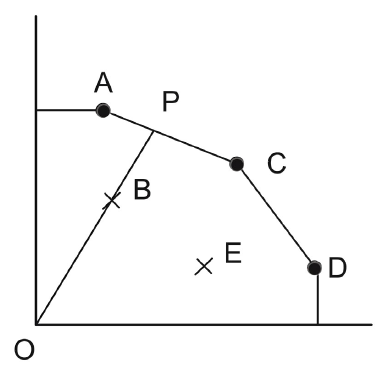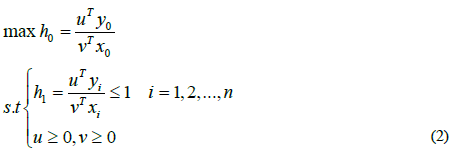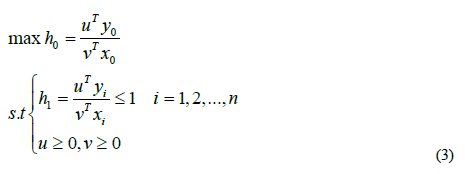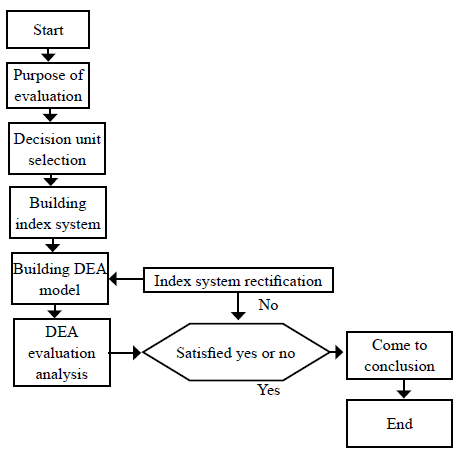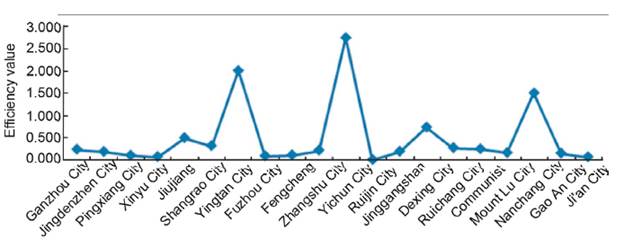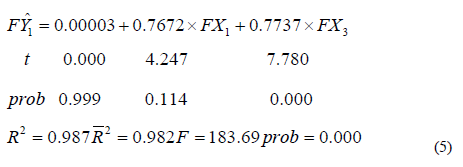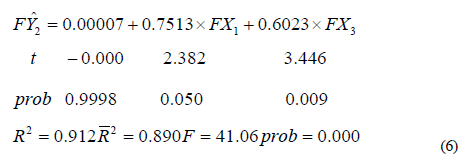1. Introduction
In the environment of global warming, ecological deterioration, and frequent extreme climate, the current agricultural drought and flood disaster prevention measures are insufficient to cope with the increasing disasters of this kind. At present, the disaster prevention system of farmland and water conservancy cannot meet the needs of agricultural disaster prevention. The practical vulnerability of existing research ideas and countermeasures is obvious (Gao et al., 2018).
The problem of prevention and control for agricultural drought and flood disasters in China has attracted the attention of relevant organizations and researchers. Currently, the research viewpoints can be roughly divided into three categories. The first is the viewpoint of engineering technology. It is considered that strengthening the construction of agricultural drought and flood prevention engineering is fundamental, and the importance of disaster early warning technology networks is emphasized (Wei et al., 2016). The second is the management mode. It is considered that the key is to change the construction and management mode of agricultural drought and flood control facilities. According to this stance, the risk management of flood and drought disasters needs closer cooperation among managers, experts, and the public (Hohmann et al., 2018). The third is comprehensive management. It is considered that a sustainable and extensive comprehensive management framework for drought and flood risk should be established, and the work system for disaster prevention should be changed from engineering system to engineering measures and nonengineering measures (Wang et al., 2017). These researches are mainly based on natural factors or man-triggered natural factors. They all focus on the control and prevention measures for agricultural drought and flood disasters but ignore the input-output efficiency.
The input-output efficiency refers to the relationship between farmland drought and flood disaster prevention. "Input" refers to the defense system before natural disasters and the various emergency measures in natural disasters. The "output" refers to the result of disaster losses without further expansion in affected regions. The larger the input-output ratio, the more reparable disaster losses are, and the stronger disaster prevention ability will be (Chen et al., 2016). There are many kinds of agricultural disasters. The primary natural disasters are drought and flood. The research on input-output efficiency mainly focuses on disaster prevention and natural disaster reduction of agricultural drought and flood. The investment includes the prevention before the disaster, the investment in meteorological early warning systems, and the investment of resources after the disasters.
Based on the connotation of input-output efficiency of the prevention and control of drought and flood disasters in agricultural land, the evaluation index system is established. The present situation and influencing factors of input-output efficiency in different regions are monitored through the evaluation model. Therefore, this paper puts forward the strategy of structural optimization to improve the prevention and control system of drought and flood disasters in modern agricultural lands.
2. Materials and methods
2.1. Mechanism of optimization of planting structure to prevent and control drought and flood disasters of cultivated lands
The change in the proportion of drought and flood disasters, the disaster rate and the rate of grain production increase are used to reflect the evolution trend of drought and flood disasters in agriculture. According to the statistical data of 1982-2010 in Table 1, the relationship among the risk, control effect, and control system of drought and flood disasters is approximately revealed. The concepts are defined as follows: The drought and waterlogging ratio refers to the ratio of the disaster area of crops caused by such a disaster. The ratio of drought and flood disaster refers to the ratio of the disaster area of crops caused by drought or waterlogging to the total disaster area of crops caused by various agricultural disasters, which is the sum of the disaster portion of drought and waterlogging. The rate of grain yield increase refers to the ratio between the increased grain output of the current year to that of the previous year (Wang & Zhang, 2019).
Table 1 Dynamic comparison of grain yield increase rate, drought and flood disaster, disaster and its ratio in 1982-2010 (unit: %)
| Particular year | Grain increase rate (last year = 100) | Affected area ratio | Proportion of disaster area | Disaster rate | Proportion of drought | Proportion of waterlogging disaster | Proportion of drought and flood |
|---|---|---|---|---|---|---|---|
| 1982 | - | 33.9 | 16.4 | 48.3 | 73.59 | 8.34 | 81.93 |
| 1984 | -3.6 | 30.5 | 20.4 | 67.0 | 47.71 | 20.49 | 68.20 |
| 1986 | 9.2 | 23.0 | 11.1 | 48.3 | 62.49 | 27.62 | 90.11 |
| 1988 | 5.3 | 22.2 | 10.9 | 49.0 | 45.06 | 34.68 | 79.74 |
| 1990 | 3.4 | 32.8 | 16.5 | 50.3 | 62.53 | 23.79 | 86.32 |
| 1992 | -2.3 | 35.2 | 16.6 | 47.2 | 64.02 | 25.70 | 89.72 |
| 1994 | 9.6 | 26.0 | 12.1 | 46.4 | 43.91 | 31.57 | 75.48 |
| 1996 | 1.8 | 34.6 | 17.5 | 50.5 | 65.95 | 17.35 | 83.30 |
| 1998 | -2.6 | 37.2 | 21.3 | 57.1 | 54.44 | 34.35 | 88.79 |
| 2000 | 8.2 | 30.9 | 14.0 | 45.3 | 29.53 | 51.23 | 80.76 |
| 2002 | 3.8 | 32.3 | 16.3 | 50.3 | 20.10 | 54.85 | 74.95 |
| 2004 | -9.2 | 35.1 | 22.1 | 63.0 | 78.03 | 12.68 | 90.71 |
| 2006 | 1.1 | 30.6 | 17.8 | 58.1 | 48.50 | 27.47 | 75.97 |
| 2008 | 9.1 | 24.3 | 10.7 | 44.0 | 53.16 | 22.40 | 75.56 |
| 2010 | 2.9 | 26.3 | 15.8 | 60.0 | 54.66 | 19.66 | 74.32 |
Fluctuation of disaster rate of agricultural drought and flood at a high level
From the perspective of the disaster rate of agricultural drought and flood in 1982-2010, the ratio of the disaster area of crops caused by drought and flood was 68%-91%, and the average annual rate is about 81.06% (Table 1). This information shows that the prevention and control ability of agricultural drought and flood disasters in China has always been at a low level in the past 29 years, and the construction of agricultural water conservancy in China has not influenced the prevention and control ability of agricultural drought and flood disasters. Meanwhile, based on the data, the prevention and control system after the reform needs to be arranged better.
Increasing the frequency of drought and flood disasters
According to the dynamic comparison between the proportion of drought and flood disasters and the yield increase rate of grain, the authors found that the frequency of the impact of the disasters on grain production increases in a period. Before the water conservancy management reform, in the period 19822010, the disaster area exceeded 2000 x 104 hm2 only in 1984 and 1990. Since 1992, the disaster areas have exceeded 2000 x 104 hm2 in eleven years (Table 1). From 1983 to 2010, grain production was negatively affected by drought and flood for 21 years, accounting for 78% of the total time. Only six years were not significantly affected by drought and flood. Excluding other factors, the length of time that grain production is significantly affected by drought and flood is enough to reflect the severe trend of the increasing frequency of affectations in grain production in China (Alexander, 2016).
The disaster losses fluctuate upward
According to the dynamic comparison between the proportion of drought and flood disasters and the rate of grain yield increase, it can be seen that both factors increased in the same direction for six years between 1983 and 1991. However, they were in the opposite direction for two years. After the reform, just in 2009, the proportion of drought and flood disasters changed in the same direction with the rate of grain production increased. In the other 18 years, they all changed in the opposite direction (Table 1). The reason is that the effect of the No. 1 document, issued by the CPC Central Committee and the State Council to support the agriculture sector in 2008, was reflected in the second year. The No. 1 document aims to increase investment in agriculture and intensify the prevention and control of floods and droughts. After the agricultural water conservancy system reform, drought and flood disaster impact on grain production is increasing.
Control activities of agricultural drought and flood could bring public benefits. In order to ensure the supply of public goods, more than a direct investment in public finances is needed, but also social and economic encouragement to participate in the supply. In China, the investment guarantee system needs to be more satisfactory.
In terms of financial investment, the central government assigned small-scale farmland and water conservancy funds for agricultural infrastructure construction to the local governments in 1984. Due to the influence of local governments' unique and efficient industrial preference, the financial support for agriculture lacked the institutional constraints of stable growth, and the limited financial support for agriculture was often occupied or misappropriated. The proportion of financial expenditure on agricultural infrastructure to the total expenditure in the same period can reflect this. In the 1980s-1990s, the financial support for the agriculture construction ratio fluctuated and declined with an average value of 2.24%. The ratio was higher than 2.23% in 1998 and the following three years, and it has declined yearly since 2003. The lowest ratio is 1.28%.
In rural cooperative investment, with the decentralization of farmers and families and the transformation of rural government functions, the village collective economy is facing the "hollowing out," and the mobilization of public affairs organizations in rural organizations is weakening. In the late 1980s, the village committee mainly relied on the voluntary labor service and labor accumulation workers, the accumulation fund system, and the fundraising of farmland and water conservancy construction. To a certain extent, this stimulates the development of farmland water conservancy construction. Due to the "obligation" basis, it cannot directly benefit farmers, so it is not an effective incentive system. If the village collective economy is in a state of "hollowing out" and the burden of farmers is worsening, the operation of the external supply system of farmland and the water conservancy system will be more difficult. Therefore, the lack of an input system for disaster prevention leads to increased vulnerability to agricultural disasters. The vulnerability to agricultural drought and flood disasters is increasing, and the disaster rate is also increasing. In addition to the force of the central government, China still needs the coordination mechanism of integrating social forces to cope with regional drought and flood disasters.
In terms of the anti-disaster engineering supply, rural water conservancy construction investment began implementing the "one project, one discussion" supply model at the end of the twentieth century instead of the financing mechanism outside the system. In the case of the "hollowing out" of the village collective economy and severe damage to farmland and water conservancy, farmers could not form a long-term practical investment expectation, and the social disaster prevention investment mechanism was challenging to develop. According to statistics, due to the lack of government investment and incentive financial and tax systems, the number of farmers working in farmland water conservancy construction has decreased from about 7.55 billion work days per year in the 1970s to more than 2 billion work days in 2004. The investment gap in farmland water conservancy is about 70 billion yuan annually. As a result, agricultural anti-disaster engineering supply faces severe shortages.
In conclusion, the failure of control measures is related to the variability of hazard factors, the breakdown of irrigation and drainage disaster prevention system, and the decline of engineering disaster prevention ability. However, the main reason lies in China's agricultural drought and flood prevention system, the lack of a solid collaborative management organization system, and the cooperative input incentive system. These reasons restrict the growth of a marketized organization of disaster prevention and control, reduce the systematic effectiveness of flood control and drought resistance behavior and weaken the response-ability to agricultural disasters. China must establish and improve the coordinated prevention and control system of agricultural drought and flood disasters as soon as possible and thus provide institutional guarantees for improving the coordination and effectiveness of prevention and control of these kinds of disasters.
2..2. Construction of input-output efficiency evaluation model for drought and flood prevention of agricultural land
Establishment of an evaluation index system
According to the concept of input-output efficiency, the evaluation index system of farmland drought and flood disaster prevention was built in Table 2.
Table 2 Evaluation index body of input-output efficiency for drought and flood control of agricultural land
| First-level index | Two-level index |
| Input index of drought and flood control for agricultural land | Agricultural drainage and irrigation diesel engine/set |
| Number of reservoirs | |
| Total reservoir capacity/100 million cubic meters | |
| Output index of drought and flood control in agricultural land | Effective irrigation area/1000 ha |
| Drainage area/1000 ha |
"Input" refers to fitting together human and material resources to prevent and control drought and flood disasters in agricultural land. The prevention and control of agricultural drought and flood disasters mainly adopt organizing human and material resources for flood discharge and irrigation. For this approach, three input indicators were selected: the number of mechanical facilities for irrigation and drainage, the total reservoir capacity, and the number of reservoirs. These indexes reflect each region's input and use of water conservancy construction and agricultural machinery. Effective irrigation and waterlogged elimination areas were selected as the output indexes of prevention and control of drought and flood, roughly reflecting the results of flood control and drought resistance.
In order to make the decision-making unit comparable, referring to the scale of agricultural output value in the 2014 China Statistical Yearbook, the authors took the cities with an agricultural output value of 100 billion yuan. Twenty cities fit into this frame. The input-output data on drought and flood prevention and control of agricultural land in twenty cities from 2010 to 2013 were taken from China Statistical Yearbook (Song et al., 2018).
2.2. DEA evaluation model
2.2.1. Data envelopment analysis (DEA)
In 1978, famous American operational research experts put forward the DEA method. It was a nonparametric method taking input/output as the efficiency of relative performance evaluation of decision-making units (DMU). It was also a complex system of effectively dealing with multi-index input and multi-index output, which could effectively evaluate the same type of department with multi-input and multi-output. DEA method has been widely applied in evaluating the effectiveness of science and technology resources allocation, the evaluation of urban community construction, the security investment funds performance, and the prevention and control of agricultural disasters. The input-output efficiency of agricultural disaster control in China is a comprehensive evaluation problem of multi-index input and multi-index output. It is unnecessary to determine the expression for the relationship between input and output. Based on the DEA model, this study analyzes the input-output situation of drought and flood control of agricultural land in China, mainly including the scale income of input-output of drought and flood control of agricultural land. The conceptual diagram of the DEA model is shown in Figure 1.
2.2.2. DEA mathematical model
Let us assume that there are decision-making units DMU i ( i = 1,2,...,n) each grain production area is a decision-making unit). In the drought and flood disaster prevention of agricultural land, each decision-making unit has kinds of input (input for prevention and control of drought and flood disaster in agricultural land) and P kinds of output (output for drought and flood disaster prevention in agricultural land). xi = (x 1i , x 2i ,...x mi )T is used to represent the input, output, and weight of the i-th decision-making unit DMU i • yi = (y 1i , y 2i ,...y mi ) T denotes its output, v i = (v i , v i ,...v m )T and u i = (u i , u i ,...u m )T represent its weight. Meanwhile, it meets xsi ≥ 0, y ti ≥ 0 (s = 1,2,...,m; t = 1,2,..., p; i = 1,2,...,n
The efficiency evaluation index of the i th agricultural production area is:
The efficiency of the i 0 -th production area is evaluated. If h io becomes larger, the study area can get more output with less input from farmland drought and flood control. Based on efficiency evaluation of DMU O , it is necessary to select the appropriate weight u, v, and maximize value of h 0 when each evaluation index is less than or equal to 1. CCR optimization model is constructed:
Formula 2 is a fractional programming model, which is transformed into a linear programming model by Charess-Cooper transformation. The definition of the optimal solution of linear programming is used to research the effectiveness of input-output of prevention and control for drought and flood disasters in regional agricultural land. Meanwhile, the dual model is adopted for in-depth analysis based on the duality theory of linear programming.
The linear programming model is built by introducing relaxation variable s-, s + and non-Archimedean infinitesimal ε.
In Formula 3, is greater than zero and less than any positive number. The input relaxation vector is and the output relaxation vector is s+, eT m= (1,1,...1)T ЄR m , eT s = (1,1,...1)T ЄR s. The optimal solution of Formula 3 is λ 0 s -0 , s+0, θ0. There are some situations:
If θ 0 > 0, the optimization of planting structure of disaster avoidance is non-DEA efficiency for the input-output of drought and flood prevention of agricultural land. It is neither the best scale nor the best technical efficiency. Therefore, it is necessary to adjust the planting structure.
If θ 0 = 1, e T M s -0 + e T S s+°>0, the optimization of planting structure of disaster avoidance is weak DEA efficiency for the input-output of drought and flood prevention of agricultural land in the researched area. That is to say, when the input x 0 is constant, the output can be increased by s + , or the input x 0 can be reduced by s - , so that the original output is unchanged. However, the planting structure of disaster avoidance cannot meet the optimal scale and technology simultaneously.
If , θ 0 =1, e T M s 0 + eT Ss+0=0, it means that the optimization of planting structure of disaster avoidance is DEA efficiency for the input and output of drought and flood prevention of agricultural land in the research area. That is to say, the optimal output y0.can be obtained by original input x0, and the planting structure of disaster avoidance can achieve scale effectiveness and technology effectiveness.
In this study, the input-oriented model is selected to analyze whether the input of planting structure optimization is practical when the output of drought and flood prevention of agricultural land in the study area is fixed. The scale efficiency refers to the distance from the efficiency frontier to the most appropriate production scale when the output is constant, and technical efficiency refers to the distance from any point to the efficiency frontier when the output is constant. The necessary condition for the criticality of optimal production scale is the unchanged scale efficiency. If the comprehensive efficiency value equals 1, the agriculture in the optimized area is DEA efficiency. If the comprehensive efficiency value is less than 1, the agriculture in the optimized area is non-DEA efficiency. If it is supposed that the pure technical efficiency of input-output is PTE, scale efficiency is SE, and comprehensive efficiency of input-output is TE, thus the relationship between them is shown as follows:
The efficiency of the i0-th production area is evaluated. If h io becomes larger, the study area can get more output with less input from farmland drought and flood control. Based on efficiency evaluation of DMJJ a it is necessary to select the appropriate weight u, v, and maximize value of h 0 when each evaluation index is less than or equal to 1. CCR optimization model is constructed: of optimization of planting structure of disaster avoidance caused by pure technical inefficiency and scale inefficiency.
2.2.3. DEA application steps
The selection of the evaluation model, evaluation unit, and relevant data will directly influence the evaluation results, which determines whether they can reflect the actual situation of the evaluation object (Lark et al., 2017). In order to make the evaluation results more authentic, objective, and scientific, it is necessary to select a decision-making unit, evaluation index system, and evaluation model scientifically. The application steps of the DEA method are shown in Figure 2.
3. Results and discussion
According to the evaluation system and evaluation model, the input-output data of drought and flood prevention of agricultural land in Jiangxi Province since the reform and opening-up were collected. According to the availability and sufficiency of data, the input-output data in twenty regions of Jiangxi Province in 2014-2017 were further selected (Turra et al., 2017). Based on the input-oriented (modified), Maxdea6.4 professional software was combined with a non-radial SBM model and super efficiency model to calculate the change of input-output efficiency of farmland drought and flood prevention in twenty regions in 2014-2017. Figure 3 shows the input and output efficiency of farmland drought and flood control under the SBM model.
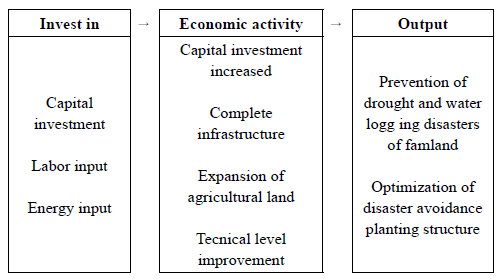
Figure 3 Changes in input-output efficiency of farmland drought and flood control under the SBM model.
3.1. Spatio-temporal difference in input-output efficiency of drought and flood control of agricultural land
The input-output efficiency of drought and flood control of agricultural land in the main cities of Jiangxi Province is generally low.
Table 3 shows that the average input-output efficiency of drought and flood prevention in significant cities of Jiangxi Province from 2014 to 2017 is less than 0.650, and there are only four cities on the effective frontier, accounting for only 20% of the analyzed cities. The input-output efficiency of drought and flood prevention in 80% of the cities needs to be revised. There was only one city with an efficiency value of 0.5-1 in 2014-2016, namely Dexing City, and two cities in 2017, Jiujiang City and Dexing City. The cities with an efficiency of 0.5-1 and more than one account for 25% of twenty cities. The input-output efficiency is less than 0.5 in 75% of the cities. In 75% of the ineffective cities, nearly half are lower than 0.2. Most urban agricultural land's drought and flood control resources have not been effectively utilized.
Table 3 Total calculation results of input-output efficiency of farmland drought and flood prevention in 20 cities of Jiangxi Province in 2014-2017
| DMU | 2014 | 2015 | 2016 | 2017 |
|---|---|---|---|---|
| Ganzhou City | 0.413 | 0.373 | 0.359 | 0.249 |
| Jingdezhen City | 0.160 | 0.132 | 0.130 | 0.198 |
| Pingxiang City | 0.144 | 0.116 | 0.112 | 0.113 |
| Xinyu City | 0.110 | 0.093 | 0.082 | 0.084 |
| Jiujiang | 1.058 | 1.049 | 1.025 | 0.510 |
| Shangrao City | 0.415 | 0.398 | 0.387 | 0.330 |
| Yingtan City | 1.160 | 1.165 | 1.169 | 2.025 |
| Fuzhou City | 0.196 | 0.185 | 0.191 | 0.102 |
| Fengcheng | 0.135 | 0.115 | 0.108 | 0.122 |
| zhangshu City | 0.281 | 0.254 | 0.252 | 0.228 |
| Yichun City | 1.052 | 1.056 | 1.061 | 2.767 |
| Ruijin City | 0.124 | 0.116 | 0.113 | 0.017 |
| Jinggangshan City | 0.325 | 0.301 | 0.294 | 0.203 |
| Dexing City | 0.613 | 0.596 | 0.584 | 0.749 |
| Ruichang City | 0.417 | 0.391 | 0.385 | 0.286 |
| Communist Youth City | 0.393 | 0.366 | 0.352 | 0.259 |
| Mount Lu City | 0.197 | 0.191 | 0.187 | 0.175 |
| Nanchang City | 4.298 | 5.447 | 5.752 | 1.520 |
| Gao'an City | 0.276 | 0.221 | 0.207 | 0.163 |
| Ji'an City | 0.358 | 0.220 | 0.222 | 0.079 |
| Average value | 0.606 | 0.639 | 0.649 | 0.509 |
The input-output spatial distribution of drought and flood disaster prevention in agricultural land is "more in the East and less in the west" (Salarikia et al., 2017).
In 2014-2016, there were three cities on the effective frontier: Jiujiang City, Yingtan City, and Yichun City. In 2017, they were two effective units: Yingtan City and Yichun City. In western China, only Nanchang was on the effective frontier from 2014 to 2017. The technical efficiency of the city with effective input-output for the prevention and control of drought and flood disasters of agricultural lands showed the characteristics of "increasing in the East and decreasing in the west" in time. In addition, the input-output efficiency of drought and flood prevention of agricultural land was decreased in Jiujiang City, and the input-output in Yingtan City and Yichun City showed strong growth. Yingtan City increased from 1.160 in 2014 to 2.025 in 2017, with an increase of 74.57%, and Yichun city increased from 1.052 in 2014 to 2.767 in 2017, with an increase of 163%. In contrast to the high-speed growth of input-output efficiency of drought and flood prevention of agricultural land in eastern Jiangxi, the efficiency value of effective cities in western Jiangxi was declining. The input-output efficiency in Nanchang has decreased from 4.298 in 2014 to 1.520 in 2017, with a decrease of 64.63%.
The index in the main agricultural cities of Jiangxi Province needs to be more balanced within the region.
Of the eight cities in the central region, Yingtan City has the highest technical efficiency (value of 2.025), and Fuzhou City has the lowest efficiency (0.102). The difference is about nineteen times. Of the four cities of the western region, Nanchang is the city with the highest technical efficiency (1.520), and Gao'an is the city with the lowest efficiency value (0.163). The difference is of about nine times. In 2010, Nanchang had the highest technical efficiency (4.298), 22 times higher than Lushan (0.197).
Figure 4. Comprehensive technical efficiency of input and output of drought and flood prevention of agricultural land in 20 cities of Jiangxi Province in 2017.
3.2. The change law ofscale and pure technical level of input-output efficiency of drought and floodprevention of agricultural land
Table 4 shows the scale and pure technical level of input-output efficiency of drought and flood prevention of agricultural land in twenty cities of Jiangxi Province in 2017, showing the following characteristics:
Table 4 Scale level and pure technical level of input-output efficiency of agricultural land drought and flood control in 20 cities of Jiangxi Province in 2017
| Decision making unit (DMU) | Comprehensive efficiency (TE) | Pure technical efficiency (PTE) | Scale efficiency (SE) | Change of scale income |
|---|---|---|---|---|
| Ganzhou City | 0.249 | 0.263 | 0.958 | Decrement |
| Jingdezhen City | 0.198 | 1.047 | 0.191 | Increase progressively |
| Pingxiang City | 0.113 | 0.261 | 0.419 | Increase progressively |
| Xinyu City | 0.084 | 0.244 | 0.366 | Increase progressively |
| Jiujiang | 0.520 | 0.532 | 0.988 | Decrement |
| Shangrao City | 0.330 | 0.332 | 1.005 | Decrement |
| Yingtan City | 2.035 | 5.433 | 0.384 | Decrement |
| Fuzhou City | 0.102 | 0.155 | 0.642 | Increase progressively |
| Fengcheng | 0.122 | 0.153 | 0.789 | Increase progressively |
| zhangshu City | 0.228 | 0.528 | 0.431 | Increase progressively |
| Yichun City | 2.767 | 2.894 | 0.967 | Increase progressively |
| Ruijin City | 0.165 | 0.358 | 0.454 | Increase progressively |
| Jinggangshan City | 0.203 | 0.448 | 0.451 | Increase progressively |
| Dexing City | 0.749 | 1.231 | 0.616 | Increase progressively |
| Ruichang City | 0.286 | 0.393 | 0.731 | Decrement |
| Communist Youth City | 0.259 | 0.789 | 0.33 | Increase progressively |
| Mount Lu City | 0.175 | 0.307 | 0.564 | Increase progressively |
| Nanchang City | 1.520 | 1.619 | 0.949 | Increase progressively |
| Gao'an City | 0.163 | 0.420 | 0.383 | Increase progressively |
| Ji'an City | 0.089 | 0.210 | 0.401 | Increase progressively |
The driving factor of the input-output effective city for preventing and controlling drought and flood disasters on agricultural lands lies in pure technical efficiency.
From the effective decision-making unit in 2017, the pure technical efficiency of Yingtan City (comprehensive efficiency value was 2.035), Yichun City (2.767), and Nanchang City (1.520) are 5.433, 2.894, and 1.619, respectively. Meanwhile, the scale efficiency is 0.384, 0.967, and 0.9498, respectively. Although the scale efficiency is lee than 1, the pure technical efficiency is far greater than 1. Finally, the technical efficiencies of these three cities are more than 1. The main reason that drives the input-output effective drought and flood prevention unit in Jiangxi Province is the high pure technical efficiency, which reflects the efficient utilization of the factor.
The driving factors of ineffective input-output cities lie purely in technical and scale efficiency factors.
From the perspective of a city whose technical efficiency value was between 0.5 and 1 in 2017, the pure technical efficiency of Jiujiang (comprehensive efficiency value was 0.520) was 0.532, and its scale efficiency was 0.988. Therefore, low pure technical and scale efficiency were the main reasons for the ineffective input and output of agricultural land drought and flood control in Jiujiang. The pure technical efficiency of Dexing City (0.749) was 1.231, while the scale efficiency was 0.616. Low-scale efficiency was the main reason for the ineffective input-output of drought and flood prevention of agricultural land in Dexing. In fact, the pure technical efficiency needs to be higher, leading to input-output ineffectiveness.
From the perspective of cities whose technical efficiency value was less than 0.5 in 2017, in addition to Jingdezhen, the reason for low technical efficiency lies in low pure technical efficiency and low scale efficiency. This includes three situations: Firstly, the scale efficiency is relatively high, and the pure technical efficiency is relatively low, such as in Ganzhou, Shangrao, Fuzhou City, Fengcheng, Ruichang, and Lushan. Secondly, the pure technical efficiency is relatively high, and the scale efficiency is relatively low, such as Gongqing. Thirdly, the comprehensive efficiency ratio and scale efficiency are relatively low.
The scale incomes of drought and flood control of agricultural land in most cities are increasing.
According to the effective decision-making unit, it can be seen that the scale income of drought and flood prevention of agricultural land in Yingtan is decreasing. However, the scale incomes of Yichun and Nanchang are increasing. From the perspective of invalid decision-making units, in addition to Ganzhou, Jiujiang, Shangrao, and Ruichang, the scale incomes of drought and flood disaster prevention and control in thirteen cities are increasing. There are fifteen cities with increasing returns to scale, accounting for 75% of the total. For most of the cities in Jiangxi Province, the scale income of prevention and control of drought and flood disasters of agricultural land is increasing.
3.3. Econometric model of input-output efficiency of drought and flood control of agricultural land in Jiangxi Province
In order to master the deep relationship between the input and output of the prevention and control of drought and flood disasters prevention in Jiangxi Province, the output of value and the output of physical quantity are taken as the explanatory variables, respectively, as the input of human, material, and financial resources in Jiangxi Province are taken as the explanatory variables for regression analysis to build the Tobit regression model. Due to the high correlation between the physical input and financial input of drought and flood prevention of agricultural land in Jiangxi Province, the t-test value is not significant in the construction of the regression measurement model, so the indexes of agricultural physical input are excluded from the econometric model.
The econometric model between the value output and the agricultural input of drought and flood prevention of agricultural land in Jiangxi Province is shown as follows:
ARCH Test: The statistics of x2 is 1.6112, and the adjoint probability is 0.4504, without autocorrelation. White Heteroskedasticity Test: The statistic is 4.3952, and the adjoint probability is 0.3676. There is no heteroscedasticity.
The proposed regression model has passed the economic, statistical, and econometric tests. This model shows that when the financial input for the prevention and control of drought and flood disasters of agricultural land in Jiangxi Province remains unchanged, the output of magnitude of value increases by 0.7672 units on average for each unit increment of human input. Suppose the input of human resources for drought and flood disaster prevention in Jiangxi Province remains unchanged. In that case, the output of magnitude of value for the drought and flood disaster prevention in agricultural land increases by 0.7737 units for each unit increment of financial input. The human input and financial input of drought and flood prevention of agricultural land in Jiangxi Province have the same impact on the value production. Comparatively speaking, the financial input of drought and flood prevention of agricultural land is more important.
The regression model has passed the economic, statistical, and econometric tests. The model shows that when the financial input for the prevention and control of drought and flood of agricultural lands in Jiangxi Province remains unchanged, the output of the value of the prevention and control increases by 0.7672 units on average for each unit of increase in human input. Under the condition that the input of human resources for drought and flood prevention in Jiangxi Province remains unchanged, the output of the value increases by 0.7737 units on average for every unit of financial input. The human and financial input of drought and flood prevention have the same impact on the value output of drought and flood prevention of agricultural land. Comparatively speaking, the financial input of drought and flood prevention of agricultural land is slightly more important.
The econometric regression model between physical output and agricultural input in Jiangxi Province is shown as follows:
ARCH Test: The statistics of x2 is 0.9774, and the adjoint probability is 0.6279, without autocorrelation. White Heteroskedasticity Test: The statistic is 4.9718, and the adjoint probability is 0.3025. There is no heteroscedasticity.
The proposed regression model has passed the economic, statistical, and econometric tests. The model shows that when the financial input for preventing and controlling drought and flood disasters of agricultural land in Jiangxi Province remains unchanged, the physical output increases by 0.7513 units on average for each unit increment of human input. If the input of human resources remains unchanged, the physical output increases by 0.6023 units for each unit increment of financial input. Human input and financial input have a slightly different impact on physical production. Therefore, the human input of drought and flood prevention of agricultural land is more important.
The analysis results show that the human and financial input in the drought and flood disaster prevention of agricultural land in Jiangxi Province have different effects on the value output and physical output.
4. Conclusion
Based on mastering the input-output efficiency and influencing factors, this paper puts forward comprehensive improvement measures for drought and flood disaster prevention in agricultural lands according to local conditions. The specific measures to improve the input of drought and flood prevention include:
Strength investment in basic facilities of flood control and drought resistance. It is necessary to increase the total fund and optimize the use structure of funds on basic flood control facilities and drought resistance to improve the use effect of that funds. The expenditure share on other types of farmland and water conservancy infrastructure should be increased while ensuring the investment in major water conservancy projects such as flood control. The investment in flood control should be gradually extended to medium and small rivers based on improving the management of large rivers. Almost 70% of 50000 small and medium rivers in China have yet to reach the flood control standard. This requires the government to adjust the expenditure structure and provide the basic facilities of flood control and drought resistance with a financial guarantee. In the investment in disaster prevention and mitigation, it is necessary to promote the optimization and regulation of water resources vigorously. The area of river basins in the north of the Yangtze River accounts for 65% of the land area in China, but water resources only account for 20%. Increasing investment in flood control and drought resistance facilities, such as cross-regional water resources, can effectively alleviate the impact of drought on grain production in water-deficient areas. Investing in disaster prevention and mitigation should focus on improving water resource utilization efficiency and changing the imbalance of disaster prevention and mitigation capacity among regions. In water conservancy and meteorology expenditure, the focus would be on science and technology's role in disaster prevention and mitigation.
Improvement of the monitoring and early warning system of government for agricultural natural disasters. Objectively, the particularity and complexity of agricultural drought and flood risk put forward higher requirements for the response system of agricultural drought and flood disasters. Therefore, it is necessary to establish a drought and flood disaster monitoring system and an agricultural vulnerability early warning and prediction system. The system should fully use "3S" technology (remote sensing technology-RS, geographic information system-GLS, and global positioning system-GPS). The precipitation, temperature, relative humidity of the soil, and other information of agricultural meteorological stations are used to carry out systematic detection and dynamic evaluation of the real-time information to make early warnings and predictions. Secondly, strengthen the division of powers and responsibilities and the organization and coordination, and then build a network risk management system for agricultural drought and flood led by government departments and participated by farmers. When implementing the responsibility system for flood and drought control, the office of flood control and drought relief at the county level and their administrative offices and responsibility system would be improved, and extend the disaster prevention function to the grass-roots unit according to local conditions. In addition, it is necessary to strengthen the construction of coordination and linkage mechanisms among the state, provinces, cities, counties, and villages and give full play to the disaster response function of organizations at all levels to conduct real-time detection and statistics of the information such as local meteorological changes, operation status of irrigation and drainage facilities and agricultural vulnerability. This network system can improve the effectiveness of drought and flood disaster prediction and prevention and mitigation measures, thus enhancing the response capacity of agricultural drought and flood disasters.
Strengthen technical research and development of agricultural products for flood control and drought resistance. Popularizing agricultural technical measures and reducing agricultural disasters is necessary. In addition, it is necessary to select "multi-resistant" varieties with high yield, stable yield, disease, and insect resistance, drought and waterlogging resistance, reform the planting system, reasonably arrange the crop structure and species, optimize the crop layout and determine the best multiple-crop index. All of them are effective measures to reduce agricultural disasters. In agricultural production, the implementation of "five good" supporting technologies, such as suitable varieties, good fields, good systems (good farming systems), suitable methods (good cultivation and management methods), and good materials (good material input), can significantly reduce agricultural disasters and ensure high and stable agricultural production.
Improvement of various forms of agricultural insurance mechanisms. Establishing and improving various agricultural insurance mechanisms and clarifying their relief is necessary. Currently, there are two forms of paid disaster relief in rural areas. The first is a special financial disaster relief fund. The national financial department or the disaster prevention and mitigation management organization manages and uses the financial reserve for disaster relief annually through funds. The agricultural disaster relief fund should have two characteristics. Firstly, the fund is to support the affected rural areas and enterprises in the form of investment and help them eliminate difficulties. Secondly, the rural disaster relief fund can be accumulated year by year. These characteristics of agricultural disaster relief funds can not only help the disaster area to overcome dependence and improve the consciousness of disaster prevention and mitigation but also correspondingly improve the ability to cope with agricultural disasters. According to the production scale, operation mode, and disaster losses in rural areas, the agricultural disaster relief accumulation fund shall be collected quantitatively. As a kind of compulsory insurance, the provident fund for disaster relief can be acted as a unified agent by the insurance company or as a source of disaster relief fund managed by the financial department. Thirdly, enterprises and institutions can jointly provide investment assistance to the affected rural enterprises. If the management system is proper, this method can help the rural enterprises in the disaster area get rid of the predicament and also help them to develop in the direction of group management.
In conclusion, the DEA model was used to analyze the input-output efficiency of the drought and flood disaster prevention of agricultural land in twenty cities of Jiangxi Province from 2014 to 2017, with a real example. The following conclusions can be drawn:
The input-output efficiency of drought and flood control in most agricultural land is low. The resources of disaster prevention and mitigation resources need to be sufficiently utilized. In 2014-2017, the input-output efficiency of drought and flood prevention of agricultural lands in major agricultural cities of four cities was on the efficient frontier, accounting for 20% of the total, and 80% of input-output efficiency was relatively ineffective. The effective input-output cities of farmland drought and flood disaster prevention show the characteristics of "more in the East and less in the west." The input-output efficiency shows the imbalance within the region.
Low pure technical efficiency and low scale efficiency are the main reasons for the ineffective input and output of drought and flood disaster prevention in most agricultural lands. However, most cities' scale benefits of drought and flood prevention are increasing. Raising the input scale can improve the drought and flood prevention of agricultural land in China.
The input of human and financial resources for the drought and flood disaster prevention of agricultural land in Jiangxi Province has the same influence on the value output. However, there is a slight difference in the impact on the output of physical quantity of drought and flood prevention in agricultural land, so the input of human and financial resources in the drought and flood disaster prevention of agricultural land in Jiangxi Province has slightly different effects on the output of value and actual output.













